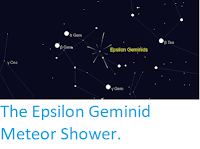The Chi Taurid Meteor Shower is visible between 20 October and 17 November
each year, with peak activity due on the night of Sunday 3 November
2019, although at its peak the shower produces less that one meteor per hour. The shower takes its
name from the constellation of Taurus, from
which the meteors appear to
radiate. Although this meteor shower is very hard to spot, there is a chance of seeing it this year as peak activity occurs not long after the New Moon on 28 October, reducing the lunar glare in the sky, and the Moon sets at about 8.00 pm, with the best viewing of the shower being at about 2.00 am.
The Radiant Point of the Chi Taurid Meteors. Modified from Dominic Ford/Map of the Constellations/In The Sky.
Meteor streams are thought to come from dust shed by comets as they come
close to the Sun and their icy surfaces begin to evaporate away.
Although the dust is separated from the comet, it continues to orbit the
Sun on roughly the same orbital path, creating a visible meteor shower
when the Earth crosses that path, and flecks of dust burn in the upper
atmosphere, due to friction with the atmosphere. In the case of the Chi Taurid meteors the dust
particles strike the atmosphere at speeds of about 147 600 km per hour,
burning up in the upper atmosphere and producing a light show in the
process, but the parent body has not been identified.
The Earth passing through a stream of comet dust, resulting in a meteor shower. Not to scale. Astro Bob.
The Chi Taurid Meteors were discovered by Peter Brown of the University of Western Ontario using the Canadian Meteor Orbit Radar at London, Ontario, a multi-frequency HF/ VHF radar used to detect the ionised trails associated with ablating meteoroids, which has been tracing meteors since 1999, recording over four million individual meteors in its first decade of operations.
See also...
Follow Sciency Thoughts on Facebook.








